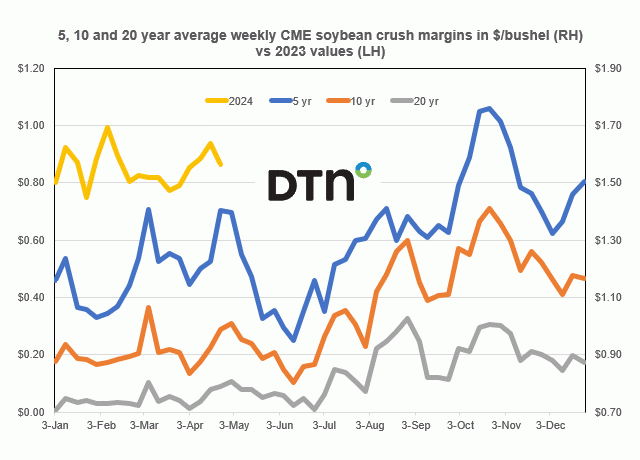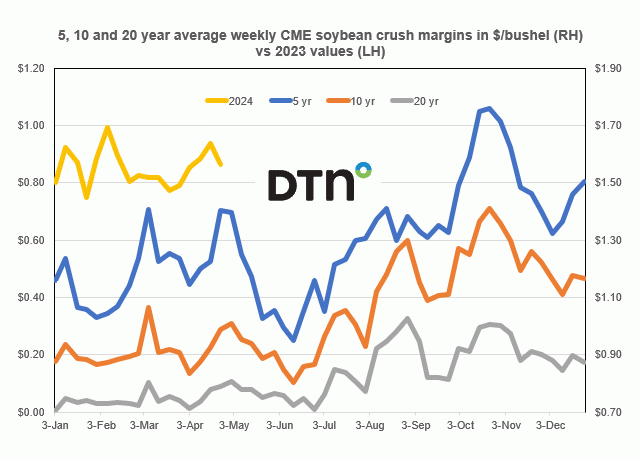Fundamentally Speaking
Soybean Processing Margins Far Weaker Than Past Few Years
One of the key supportive factors for soybean futures last year was very strong crush margins that prompted soybean processors to bid aggressively for whatever soybeans were around.
In 2023, the CME soybean crush margins at certain points in the year were close to $3.00 per bushel while interior cash soybean processing margins were even higher.
The average 2023 weekly soybean crush margin last year was $1.77 per bushel, a very heady price though down from the 2022 average of $2.05, which was the highest ever topping the 2018 peak of $1.41 and about double the 2021 average of $1.03 per bushel.
This year, however, has been a different story as CME crush margins have crashed to an average of $0.86 per bushel since the start of the year.
P[L1] D[0x0] M[300x250] OOP[F] ADUNIT[] T[]
Soybeans are processed into soybean oil and soybean meal with a few soybean hulls so the stronger the product values are (oil and meal) relative to soybeans the more profitable it is to crush soybeans.
Since August of 2023 however, the products have been relatively weaker.
Nearby soybean oil is now trading close to its lowest levels since February 2021 as weaker overseas vegetable oil prices, subdued demand, and rising production linked to the expanding renewable biodiesel industry have weighed on that market.
Meanwhile, soybean meal as of earlier this month was down at the lowest levels since November 2021 as a near doubling of the Argentine soybean crop will once again result in that country being the largest soybean meal exporting nation in the world, putting a cap on over overseas sales efforts.
On the other hand, soybean prices have receded but not to the degree seen for the products.
This chart shows the five-, ten- and twenty-year average weekly CME soybean crush margins in dollars per bushel on the right-hand axis and the weekly 2024 values on the left-hand axis.
One can see that the 2024 crush margins have hovered between 80 and 90 cents per bushel since the start of the year mimicking the seasonal pattern exhibited by the 5, 10 and 20-year averages and even more so over the past five seasons.
Margins contracted in March but rather than pop higher in April, as is the seasonal pattern, they continued to move sideways.
Right now, the weekly margins are well below the respective five-year average at this time of year but close to both the 10- and 20-year average.
Seasonally margins usually fall this time of year right into the beginning of July where they push higher into the start of harvest, so we will see how things transpire over the next few weeks.
(c) Copyright 2024 DTN, LLC. All rights reserved.





Comments
To comment, please Log In or Join our Community .